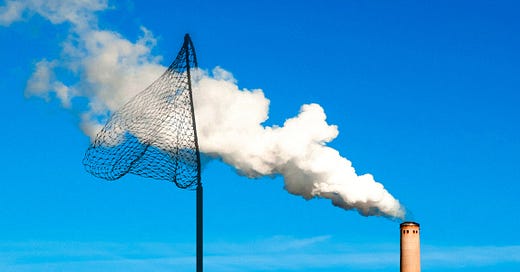🏭carbon isn't entirely bad: the profit opportunities of co2
a small taste of carbon capture and its market opportunity today and tomorrow
hey! welcome to my newsletter.🌿 in case you do not know me: i’m mafer, an 18-year-old peruvian incoming freshman at stanford university, climate tech enthusiast and boba tea connoisseur. i’m very glad to have you here.
simply said: reaching net zero will be impossible without carbon capture. it can help with both balancing emissions across the energy system AND offset emissions from outside the energy sector as well. how cool does that sound?
still, the solution has never been that easy as just implemented technologies that take all our co2 from the atmosphere. we must find a way to incentivize this carbon capture —in the end of the day, we cannot talk about technology without its economic incentives. right now, co2 is not particularly valuable (or at least not as valuable as it can get), so multiple startups are focusing on the valorisation of co2. take as an example enerkem, which converts non-recyclable, non-compostable waste into biofuels and other renewable chemicals, or econic (iconic name ngl), creating value out of co2 by creating plastic with catalyst technologies.
in the mire of increasing costs of greenhouse gas emissions in the near future, carbon capture, utilization and storage will be at the forefront of cost efficiency. so get comfy, get some tea (tea > coffee, fight me) and sit back, because i will now explain you a bit about the co2 revalorisation landscape.
i will first introduce you to the risks of co2 being seen as solely a pollutant, then we will dive more into what carbon capture actually is, next a brief overview of the type of technologies existing today and, finally, we will close up with methods to valorise co2 through both revenue streams and, on a more technical side, chemical conversion processes.
🚫the problem: seeing co2 as “waste”
the concept is (somewhat) simple to visualize. and what better way to visualize than with a graph?
it is painfully obvious how the energy sector wins the price of the biggest greenhouse gas emittor with a 73.2%. this is mainly because our society has relied on fossil fuels waaay too much for energy production, which is now a big problem for our planet as they are the biggest co2 emittors globally.
specifically for co2 emissions, we can see that due to fossil fuels (amongst other smaller co2 emittors) there is now 12 billion extra tonnes of co2 in the atmosphere that will need to be removed by 2050 if we want to imit global warming to 1.5 degrees celcius. even assuming that net zero is achieved in all industries, removing that extra co2 will be needed if we want to reverse the effects of climate change.
so, what should we do?
the problem, i argue, is that co2 is currently seen as mere waste. partially, it is true that co2 is a by-product of energy-based industrial processes that is not easily reused, but repurposing it might be the next disruptive technologies of tomorrow.
“the policies we've got at the moment are good for starting off on the journey, but they … definitely won't get to the end point of the journey. there are ways of achieving these goals, but we haven't been bold enough to do them.” - stuart haszeldine, professor of carbon capture and storage the university of edinburgh, 2021
disincentivising the use of fossil fuels will not be enough and neither fast enough for what our planet needs. instead of dealing with the messy output, the cleanest way to cutting greenhouse emissions is to use renewable electricity as the main energy source — but this isn’t always feasible. planting trees to suck up carbon from the atmosphere could be another crucial piece of the puzzle, but it’s a slow and steady kind of solution (it actually just absorbs 2 billion tonnes of co2 out of the 12B that we need), one that will take years to scale and bring meaningful change. then, what should we invest in? a promising bet could be to capture and store that co2 before it reaches the atmosphere in the first place, and here is where carbon capture gets into play.
🥜carbon capture in a nutshell
carbon capture, utilization, and storage (CCUS) captures co2 from large point sources (e.g. power generation or industrial facilities) that uses either fossil fuels or biomass as a fuel. trapped, we have two main options:
transport it for other uses
inject it into deep geological formations to store it
right now, most of the co2 captured is being stored underground, but some main concerns about this are possible leakages from underground reservoirs and induced seismicity (if you’re interested, you can read more about these challenges here).
to explain the main limitation of carbon valorisation, we first need a brief chemistry 101 lesson. simply put, co2 is a stable molecule. each oxygen atom haves two electron pairs with the carbon atom, and since there is a strong carbon-oxygen bond (oops), then the problem arises. we need a high energy input to break it down and transform it.
this energy could be induced by heat, electricity or light. in fact, even a catalyst could be used to lower the co2 conversion energy barrier and reduce the energy level needed for trasformation. there are various ways in which startups and researchers are looking into the most efficient way to transform co2 into something more valuable that could actually create revenue, and here i explain you some of the most promising ones!
🕐carbon capture technologies today: what is being done?
some of the most advanced capture technologies up to date are chemical absorption, physical separation, membranes and looping cycles (e.g. chemical looping and calcium looping). additionally, there are also innovations in the field to reduce CCUS costs for power generation. one of these is NET power 50 mw clean energy plants, a first-of-a-kind natural gas-fired power plant employing allam cycle tech, which uses co2 instead of steam as a working fluid to drive turbines that generate power. here is video giving a very condensed overview of the allam cycle (i highly encourage you to have a look!)
but far more than the technical wonders of these inventions, a focus on the market is also crucial. as of 2022, there are 35 commercial facilities that capture 45 Mt CO2 globally, and it is actually projected to increase to 200 facilities in 2030 capturing 220 Mt co2. there is a big market opportunity, and we cannot let it slide!
our friends here show the importance of this. the picture shows the competitive landscape of startups that work on co2 valorisation. but, why? by 2050, electricity demand is expected to triple due to nations’ economic growth; however, in a sustainable development scenario, there will not be enough raw materials to cover this demand. eventually, bioenergy with CCS (BECCS) will be needed for a clean transition.
“45% of growth is expected to come from BECCS and 15% from direct air capture (DAC). the ideal is that 1/5 of co2 captured from bioenergy is used in combination with green hydrogen to produce synthetic hydrocarbon fuels - IEA, 2023
because of the pressing need to accelerate this shift, the focus now is one: value co2 in a way that also creates revenue as an economic incentive.
💲co2 valorisation: an intro to carbon capture revenue
profits can be maximized through two main strategies: decreasing costs or increasing revenue. to do so, we need to consider possible revenue streams to put co2 into use. during ari global’s session today, we did a research sprint about possible industries co2 could be used in to increase profits. these varied from dry ice to carbon fiber production. here are some of my main takeaways:
even if at first sight it might seem that carbon capture is non-profitable —it is! we just have to take some minutes to find those gaps. for example, aerospace-grade carbon fiber has a cost of $100 per pound and, in 2021, 150,000 tonnes of carbon fiber were sold. with aerospace being one of the next big industries being developed, the already existing demand for it would also be expected to grow.
previous brainstorming is KEY when trying to find alternative impacts one industry could have on another. one could think that solution ideation might be the only worth contender of brainstorming, but actually finding the gap could be defined by an out-of-the-box idea.
focusing on expected rate of growth of diverse industries is relevant when deciding what to do now. in fact, the group that brainstormed the use of co2 in dry ice emphasized that the growth of the dry ice industry will be of $670 million by 2030, including a comprehensive graph that showed how, apart from its already high market value, this revenue stream could be even more promising in the future.
the possibilities, even if they seem limited at first, are endless. and to achieve these types of revalorization in diverse industries, we also need to have a broad understanding of chemical valorisation methods being tried by these startups. take a look at some of them!
🔥thermochemical conversion: uses heat as an energy source + catalyst. they produce long-chain hydrocarbons that have only been produced with this method until today. particularly benefitial as long-chain hydrocarbons store more energy and are easier to trasport compared to gaseous methane.
⚡electrochemical conversion: uses electricity to break the bonds. it is less developed in technology readiness level (TRL) compared to thermochemical conversion but it’s still promising due to the possibility of producing carbon nanomaterials (used in energy storage).
🌞photochemical conversion: uses solar light as energy input source. it is argued that the most promising pathway for this conversion type is to leverage photocatalytic material properties with other modes of energy input for co2 conversions (e.g. photothermal catalysis, photoelectrochemical catalysis, bio-photocatalysis)
🧬biological conversion: it is still a very emerging conversion, but the idea is to use microorganisms to convert co2. even though there is still a lot of research to be done, oprimizing capabilities thorugh genetic engineering could become a disruptive technology in the near future.
without a doubt, carbon capture is a promising field and there is space of improving cost-efficiency, but there is still a lot that needs to be done. i will be diving more into the technical limitations of the technologies themselves in a future post. until then, there is no doubt that carbon valorisation still has a lot on store for the future.











